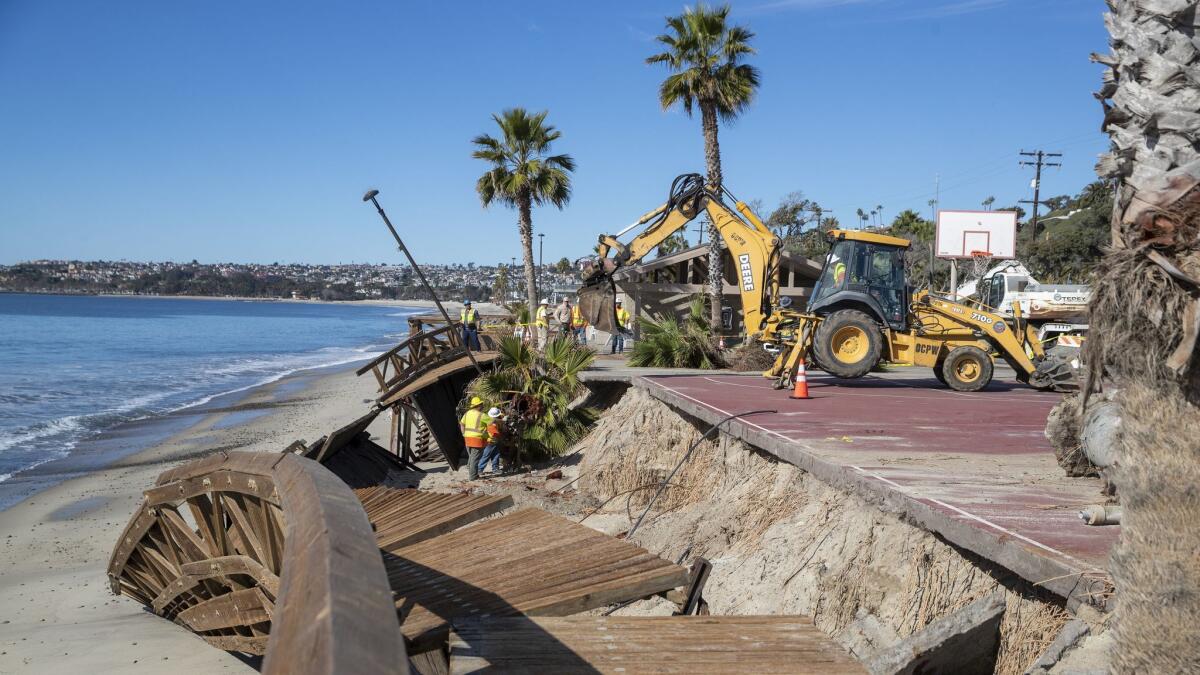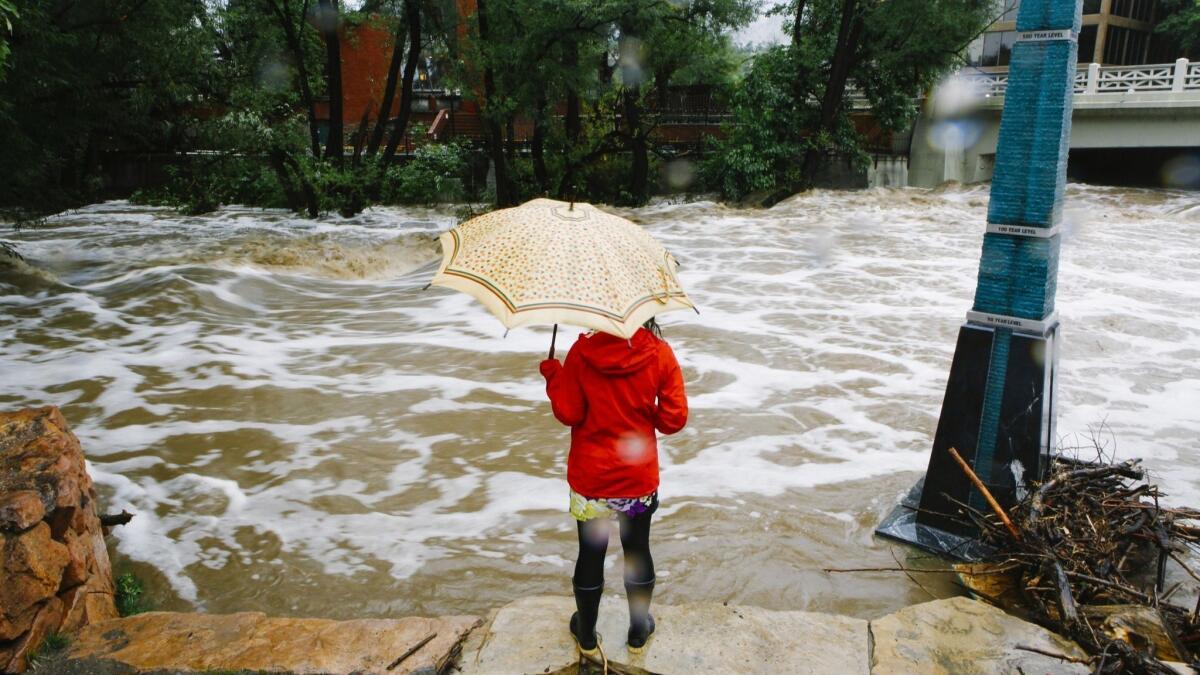From ruined bridges to dirty air, EPA scientists price out the cost of climate change

By the end of the century, the manifold consequences of unchecked climate change will cost the U.S. hundreds of billions of dollars per year, according to a new study by scientists at the Environmental Protection Agency.
Those costs will come in multiple forms, including water shortages, crippled infrastructure and polluted air that shortens lives, according to the study in Monday’s edition of Nature Climate Change. No part of the country will be untouched, the EPA researchers warned.
However, they also found that cutting emissions of carbon dioxide and other greenhouse gases, and proactively adapting to a warming world, would prevent a lot of the damage, reducing the annual economic toll in some sectors by more than half.
Experts called the report the most comprehensive analysis yet of the staggering diversity of societal impacts that climate change will have on the American economy.
“It is an extraordinarily ambitious project,” said Solomon Hsiang, an economist at UC Berkeley who was not involved in the study.
The analysis is not the first to calculate the costs of global warming and the benefits of curtailing emissions. There have been numerous prior attempts, including a 2006 report commissioned by the British government that found unmitigated warming could reduce global gross domestic product by as much as 20%.
Many more have followed, but all reach the same general conclusion, said Brenda Ekwurzel, director of climate science at the Union of Concerned Scientists: “The cost of inaction is really high, and [the cost of] reducing emissions pales in comparison.”
What sets the new study apart, she said, is its astonishing level of detail. It explores how 22 different impacts of climate change — from rising sea levels to longer pollen seasons to the economic prospects of ski resorts — will play out across the nation.
“There are no regions that escape some mix of adverse impacts,” wrote authors Jeremy Martinich and Allison Crimmins.
The findings clash with the views of President Trump and many of his appointees, who have repeatedly downplayed the risks of climate change. The EPA did not make the study authors available for interviews.
The report summarizes years of work by scores of scientists as part of the EPA’s Climate Change Impact and Risk Analysis.
For each type of impact, researchers modeled the effects of climate change under a scenario in which the world took no serious actions to reduce emissions. They also considered a more moderate scenario — one not ambitious enough to meet international goals of keeping warming to about 1.5 degrees C above pre-industrial levels but aggressive enough to limit global temperature rise to about 2 degrees C.
Some of the results came out in the Fourth National Climate Assessment, released last year.
Among them were the sobering projections that damage to coastal property, primarily on the Gulf and East coasts, will reach $120 billion per year by 2090; lost labor productivity due to hotter temperatures, particularly in the South and Midwest, will cost $155 billion per year; and deaths from extreme heat waves and cold snaps will equal $140 billion per year.
When asked about those conclusions in November 2018, Trump told reporters, “I don’t believe it.”
The new study offers an even richer picture of the EPA’s analysis, said Ekwurzel, who contributed to the climate assessment. It shows how many of the effects of climate change break down by state — and often by individual county or watershed.
“It’s kind of like, all politics is local. Climate change is the same,” she said: Every place will face a unique combination of climate impacts.
The results align with those of a 2017 study led by Hsiang, which suggested that the southern U.S. will be particularly hard hit thanks to the converging effects on coastal property, labor productivity and extreme temperature mortality. But the new analysis shows that no region will be exempt from losses.
For instance, most of the northern half of the country will experience greater air pollution because of climate change. The Midwest will see more harmful algal blooms, like those that have choked Lake Erie in recent years. And the Northwest will experience a spike in electricity demand, mainly for cooling, and endure more severe flooding.

A handful of places could enjoy small economic gains in certain sectors. The results suggest that some parts of the inter-mountain West may get a boost in water supply, for example.
But California won’t be so lucky. Residents have already become familiar with some of the climate impacts that will become more common in the state, such as wildfires and flooding.
The study suggests that climate change will also bring more mosquitoes that carry West Nile virus. It will increase the temperatures of streams and lakes, reducing oxygen levels and harming water quality. Heavy river flows will put many bridges at risk, and intense heat will buckle rail lines.
The report also makes one of the first attempts to study the connections between various climate impacts. For instance, the authors note that energy costs will rise more dramatically in places where increased energy demand coincides with reduced water supply, because many power plants require water for cooling.
However, the researchers point out that the high cost of climate impacts can be recast as the benefits the country stands to reap by cutting greenhouse gas emissions. Keeping warming closer to 2 degrees would prevent tens of billions of dollars in lost labor productivity, extreme temperature mortality and energy costs alone.
Across all sectors, that works out to between $250 and $600 of savings per person per year by the end of the century, the researchers calculated.
“You can really save the U.S. economy lots of money,” Ekwurzel said.
In some cases, reducing emissions will not be enough to avoid impacts. For instance, coastal areas will see more sea-level rise in coming decades, even if the world acts swiftly.
So the researchers considered how efforts to adapt to a warmer world might reduce economic damages.
They found that measures such as elevating buildings and constructing seawalls could significantly decrease damage to coastal properties. Maintaining roads and railroads — preferably before they fall into disrepair — could also offset many of the costs of climate impacts.

Overall, however, experts said the study still probably underestimates the true cost of climate change.
“There are big uncertainties, but in general, the uncertainties always err on the side of making it more damaging,” said Frances Moore, a climate change economist at UC Davis who was not involved in the study.
That’s because no study can include every sector of the economy, and some impacts — like the potential for global warming to fuel violent conflicts and spur migration — are almost impossible to quantify but will most likely add to the burden, she said.
Even so, Hsiang said the new research lays the groundwork for a meaningful conversation about the risks of letting climate change continue unabated.
“The climate may be one of the largest economic assets this nation holds,” he said. “We should manage it with the seriousness and clarity of thought that we would apply to managing any asset that generates trillions of dollars in value.”







